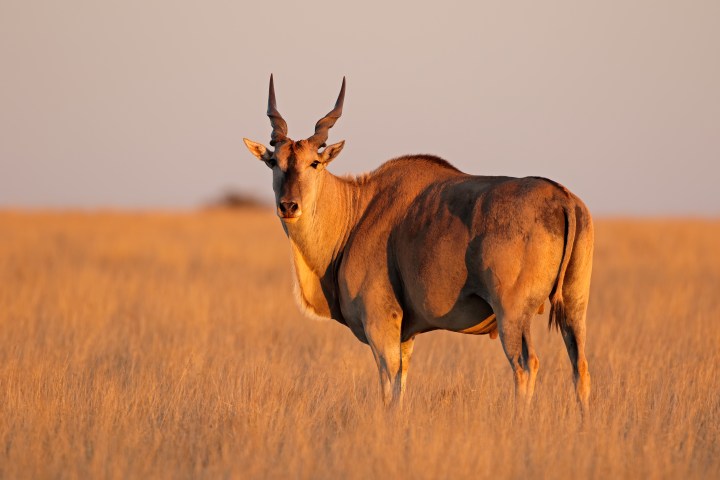KAROO KITCHEN
In thrall to the King of Venison

When eland is bestowed on your Karoo kitchen, you are honoured. When preparing it for the pot, you treat it with humility and respect.
When you tread in the footsteps of ancient San, along the paths to where their art is preserved in blood-like red ochre on rock faces and where their depictions of a particular antelope entrance you, you are venturing into realms where you may well feel there are eyes watching you.
You may think, as many do, that they are paintings of cattle; many have made that mistake. But almost every such creature you see in our rock art is an eland that once roamed the nearby veld, right where you’re standing in awe of the artist’s work. The omniscient eye of the San held the eland in high esteem and when they painted it on rocks in the depths of caves they believed they were opening portals to the spirit world. They revered the beast.
In our brash times, the thinking farmer whose land may contain eland may allow, once in a rare while, the shooting of an eland for the pot; but it is permission that is not granted lightly. When this was allowed, recently, and portions of its fine meat arrived at my kitchen door, it was a red letter day.
There’s a reason why the eland, as it was explained when I asked for context, was worshipped by the San, and a key icon of their belief system. It’s the king of venison, a giant of an antelope, the size of a cow. Its meat is fine of texture and flavour, and its layers of intramuscular fat certainly enhance its taste. It’s not at all “gamey” and is much like beef, but better. It has been described as a good meat to offer those who don’t like the “gamey” flavour of some venison.
Closer to beef in flavour than any other venison, the meat of this giant is a tiny bit coarser in texture than beef, but this is not a negative point. It only enhances your enjoyment of it.
At the potjie and braai gathering that naturally ensued once this prized meat had been presented to me, I used cubes of meat for a potjie (find the recipe for it here), and a chunk of fillet to be cooked with care on the coals, seasoned only with salt and pepper, so that we could taste the pure flavour of the eland meat, unadulterated.
The man who had been permitted to shoot this eland had been invited too, and he was well informed about the meat and how it should be cooked. He spoke of it with the requisite respect. Once the mildly seasoned fillet had been turned three or four times on the coals, we called him to join us and, after prodding it with a finger, he said simply, “a few minutes more”. Eland, perhaps because of that coarser texture, needs slightly longer cooking than a similar cut of beef fillet. And though in appearance it is almost identical to beef fillet, it’s when you bite into it that you soon identify its distinction.
After about 15 minutes I took it off the fire and inside to have a closer look. Sliced through, it was textbook medium rare, exactly what I’d wanted. The three of us, the farmer, the hunter and the townie cook, tasted, rolled our eyes happily, and sighed the sigh of the content.
It had seemed as though there was an almighty battle raging in the heavens that afternoon as the gods gathered the clouds and threw down lashings of rain. On his way to town from the farm through the magnificent pass for the feast, massive bolts of lightning cast from on high had cracked on both sides of the bakkie as they crept along. There are times when we are made to respect what has been granted for the pot.
But clear skies are not required for the bringing out of the three-legged potjie, and there is a piece of roof over my head on that part of the werf, as we call even my modest piece of townie land in these eastern parts of the Great Karoo. Later, there would be clearer skies when we could clink a glass in front of the midnight kakpraatvuur (let’s just say “fire”), remember the savouring of the granted meat hours earlier, and tell tall country tales. We’d drink a toast to the great beast and commune as best we could with the spirits of those who walked these plains long before palefaces arrived from other continents.
The eland was honoured on this day. DM/TGIFood
Tony Jackman is Galliova Food Champion 2021. His book, foodSTUFF, is available in the DM Shop. Buy it here.
Follow Tony Jackman on Instagram @tony_jackman_cooks. Share your versions of his recipes with him on Instagram and he’ll see them and respond.
SUBSCRIBE to TGIFood here. Also visit the TGIFood platform, a repository of all of our food writing.




 Become an Insider
Become an Insider
Having had the privilege of savouring an eland fillet on the braai, I can heartily agree with your verdict Tony, it is sublime!
Thank you for the historical context and giving this rare treat the respect it deserves! Your writing is outstanding as always, we eat using all of our senses… look, smell and taste and then listen to the sighs of appreciation and the stories that follow!
I once had a book by Laurens van der Post, “First Shoot Your Eland” a book about the food of Africa. I think it is with all my single socks.